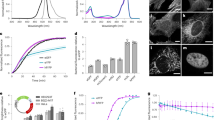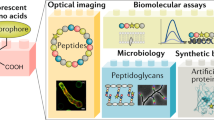Abstract
Fluorescent proteins have revolutionized cell biology and cell imaging through their use as genetically encoded tags. Structural biology has been pivotal in understanding how their unique fluorescent properties manifest through the formation of the chromophore and how the spectral properties are tuned through interaction networks. This knowledge has in turn led to the construction of novel variants with new and improved properties. Here we describe the process by which fluorescent protein structures are determined, starting from recombinant protein production to structure determination by molecular replacement. We also describe how to incorporate and determine the structures of proteins containing non-natural amino acids. Recent advances in protein engineering have led to reprogramming of the genetic code to allow incorporation of new chemistry at designed residue positions, with fluorescent proteins being at the forefront of structural studies in this area. The impact of such new chemistry on protein structure is still limited; the accumulation of more protein structures will undoubtedly improve our understanding and ability to engineer proteins with new chemical functionality.
Access this chapter
Tax calculation will be finalised at checkout
Purchases are for personal use only
Similar content being viewed by others
References
Rodriguez EA, Campbell RE, Lin JY et al (2017) The growing and glowing toolbox of fluorescent and photoactive proteins. Trends Biochem Sci 42:111–129. https://doi.org/10.1016/j.tibs.2016.09.010
Duwe S, Dedecker P (2019) Optimizing the fluorescent protein toolbox and its use. Curr Opin Biotechnol 58:183–191. https://doi.org/10.1016/j.copbio.2019.04.006
Shaner NC, Steinbach PA, Tsien RY (2005) A guide to choosing fluorescent proteins. Nat Methods 2:905–909. https://doi.org/10.1038/nmeth819
Tsien RY (1998) The green fluorescent protein. Annu Rev Biochem 67:509–544. https://doi.org/10.1146/annurev.biochem.67.1.509
Chalfie M, Tu Y, Euskirchen G et al (1994) Green fluorescent protein as a marker for gene-expression. Science (80- ) 263:802–805. https://doi.org/10.1126/science.8303295
Ormo M, Cubitt AB, Kallio K et al (1996) Crystal structure of the Aequorea victoria green fluorescent protein. Science (80-) 273:1392–1395
Yang F, Moss LG, Phillips GN Jr (1996) The molecular structure of green fluorescent protein. Nat Biotechnol 14:1246–1251. https://doi.org/10.1038/nbt1096-1246
Matz MV, Fradkov AF, Labas YA et al (1999) Fluorescent proteins from nonbioluminescent Anthozoa species. Nat Biotechnol 17:969–973. https://doi.org/10.1038/13657
Wall MA, Socolich M, Ranganathan R (2000) The structural basis for red fluorescence in the tetrameric GFP homolog DsRed. Nat Struct Biol 7:1133–1138
Merzlyak EM, Goedhart J, Shcherbo D et al (2007) Bright monomeric red fluorescent protein with an extended fluorescence lifetime. Nat Methods 4:555–557. https://doi.org/10.1038/nmeth1062
Lambert TJ (2019) FPbase: a community-editable fluorescent protein database. Nat Methods 16:277–278. https://doi.org/10.1038/s41592-019-0352-8
Arpino JAJ, Rizkallah PJ, Jones DD (2012) Crystal structure of enhanced green fluorescent protein to 1.35 angstrom resolution reveals alternative conformations for Glu222. PLoS One 7. https://doi.org/10.1371/journal.pone.0047132
Heim R, Prasher DC, Tsien RY (1994) Wavelength mutations and posttranslational autoxidation of green fluorescent protein. Proc Natl Acad Sci U S A 91:12501–12504
Reddington SC, Rizkallah PJ, Watson PD et al (2013) Different photochemical events of a genetically encoded phenyl azide define and modulate GFP fluorescence. Angew Chemie-International Ed 52:5974–5977. https://doi.org/10.1002/anie.201301490
Craggs TD (2009) Green fluorescent protein: structure, folding and chromophore maturation. Chem Soc Rev 38:2865–2875. https://doi.org/10.1039/b903641p
Barondeau DP, Kassmann CJ, Tainer JA, Getzoff ED (2005) Understanding GFP chromophore biosynthesis: controlling backbone cyclization and modifying post-translational chemistry. Biochemistry 44:1960–1970. https://doi.org/10.1021/bi0479205
Barondeau DP, Kassmann CJ, Tainer JA, Getzoff ED (2006) Understanding GFP posttranslational chemistry: structures of designed variants that achieve backbone fragmentation, hydrolysis, and decarboxylation. J Am Chem Soc 128:4685–4693. https://doi.org/10.1021/ja056635l
Barondeau DP, Tainer JA, Getzoff ED (2006) Structural evidence for an enolate intermediate in GFP fluorophore biosynthesis. J Am Chem Soc 128:3166–3168. https://doi.org/10.1021/ja0552693
Rosenow MA, Huffman HA, Phail ME, Wachter RM (2004) The crystal structure of the Y66L variant of green fluorescent protein supports a cyclization-oxidation-dehydration mechanism for chromophore maturation. Biochemistry 43:4464–4472. https://doi.org/10.1021/bi0361315
Auhim HS, Grigorenko BL, Harris TK et al (2021) Stalling chromophore synthesis of the fluorescent protein Venus reveals the molecular basis of the final oxidation step. Chem Sci 12:7735–7745. https://doi.org/10.1039/d0sc06693a
Patterson GH, Lippincott-Schwartz J (2002) A photoactivatable GFP for selective photolabeling of proteins and cells. Science (80- ) 297:1873–1877. https://doi.org/10.1126/science.1074952
Remington SJ (2011) Green fluorescent protein: a perspective. Protein Sci 20:1509–1519. https://doi.org/10.1002/pro.684
van Thor JJ (2009) Photoreactions and dynamics of the green fluorescent protein. Chem Soc Rev 38:2935–2950. https://doi.org/10.1039/b820275n
Worthy HL, Auhim HS, Jamieson WD et al (2019) Positive functional synergy of structurally integrated artificial protein dimers assembled by Click chemistry. Commun Chem 2. https://doi.org/10.1038/s42004-019-0185-5
Royant A, Noirclerc-Savoye M (2011) Stabilizing role of glutamic acid 222 in the structure of Enhanced Green Fluorescent Protein. J Struct Biol 174:385–390. https://doi.org/10.1016/j.jsb.2011.02.004
Jumper J, Evans R, Pritzel A et al (2021) Highly accurate protein structure prediction with AlphaFold. Nature 596:583–589. https://doi.org/10.1038/s41586-021-03819-2
Baek M, DiMaio F, Anishchenko I et al (2021) Accurate prediction of protein structures and interactions using a three-track neural network. Science (80- ) 373:871–876. https://doi.org/10.1126/science.abj8754
Larsson AM (2009) Preparation and crystallization of selenomethionine protein. In: Bergfors TM (ed) IUL biotechnology series 8 (protein crystallization), 2nd edn. International University Line, p 135154
Hendrickson WA, Horton JR, LeMaster DM (1990) Selenomethionyl proteins produced for analysis by multiwavelength anomalous diffraction (MAD): a vehicle for direct determination of three-dimensional structure. EMBO J 9:1665–1672
Liu CC, Schultz PG (2010) Adding new chemistries to the genetic code. In: Kornberg RD, Raetz CRH, Rothman JE, Thorner JW (eds) Annual review of biochemistry, vol 79, pp 413–444
Crameri A, Whitehorn EA, Tate E, Stemmer WPC (1996) Improved green fluorescent protein by molecular evolution using DNA shuffling. Nat Biotechnol 14:315–319. https://doi.org/10.1038/nbt0396-315
Wang F, Niu W, Guo J, Schultz PG (2012) Unnatural amino acid mutagenesis of fluorescent proteins. Angew Chemie-Int Ed 51:10132–10135. https://doi.org/10.1002/anie.201204668
Hammill JT, Miyake-Stoner S, Hazen JL et al (2007) Preparation of site-specifically labeled fluorinated proteins for 19F-NMR structural characterization. Nat Protoc 2:2601–2607. https://doi.org/10.1038/nprot.2007.379
Plass T, Milles S, Koehler C et al (2011) Genetically encoded copper-free click chemistry. Angew Chemie-Int Ed 50:3878–3881. https://doi.org/10.1002/anie.201008178
Winter G (2010) xia2: an expert system for macromolecular crystallography data reduction. J Appl Crystallogr 43:186–190. https://doi.org/10.1107/S0021889809045701
Evans P (2006) Scaling and assessment of data quality. Acta Crystallogr Sect D 62:72–82. https://doi.org/10.1107/S0907444905036693
Collaborative (1994) The CCP4 suite: programs for protein crystallography. Acta Crystallogr Sect D 50:760–763. https://doi.org/10.1107/S0907444994003112
McCoy AJ, Grosse-Kunstleve RW, Adams PD et al (2007) Phaser crystallographic software. J Appl Crystallogr 40:658–674. https://doi.org/10.1107/S0021889807021206
Jia-xing Y, Woolfson MM, Wilson KS, Dodson EJ (2005) A modified ACORN to solve protein structures at resolutions of 1.7Å or better. Acta Crystallogr Sect D 61:1465–1475. https://doi.org/10.1107/S090744490502576X
Foadi J, Woolfson MM, Dodson EJ et al (2000) A flexible and efficient procedure for the solution and phase refinement of protein structures. Acta Crystallogr Sect D 56:1137–1147. https://doi.org/10.1107/S090744490000932X
Jia-xing Y, Woolfson MM, Wilson KS, Dodson EJ (2002) ACORN – theory and practice. Zeitschrift für Krist – Cryst Mater 217:636–643. https://doi.org/10.1524/zkri.217.12.636.20655
Yao J (2002) ACORN in CCP4 and its applications. Acta Crystallogr Sect D 58:1941–1947. https://doi.org/10.1107/S0907444902016621
Emsley P, Cowtan K (2004) Coot: model-building tools for molecular graphics. Acta Crystallogr Sect D 60:2126–2132. https://doi.org/10.1107/S0907444904019158
Murshudov GN, Vagin AA, Dodson EJ (1997) Refinement of macromolecular structures by the maximum-likelihood method. Acta Crystallogr Sect D 53:240–255. https://doi.org/10.1107/S0907444996012255
Long F, Nicholls RA, Emsley P et al (2017) AceDRG: a stereochemical description generator for ligands. Acta Crystallogr Sect D 73:112–122. https://doi.org/10.1107/S2059798317000067
Acknowledgments
We would like to thank the staff at the Diamond Light Source (Harwell, UK) for the supply of facilities and beam time, especially beamlines I02, I03, and I04 staff, under beamtime code mx18812. This work was supported by BBSRC (BB/H003746/1 and BB/M000249/1) and EPSRC (EP/ J015318/1) grants (to DDJ). RDA was supported by KESS 2-Tenovus studentship and HSA by the Higher Committee for Education Development in Iraq. We would like to thank the Protein Technology Hub, School of Biosciences, Cardiff University, for use of facilities to generate protein and analyze protein essential to structural studies. We would also like to thank Ben Bax and Magdalena Lipka-Lloyd for help with protein crystallization. Finally, we are eternally grateful to Pierre Rizkallah for helping with all aspects of protein crystallography over the years and teaching many members of the DDJ group how to determine protein structures—we salute you, sir.
Author information
Authors and Affiliations
Corresponding author
Editor information
Editors and Affiliations
Rights and permissions
Copyright information
© 2023 The Author(s), under exclusive license to Springer Science+Business Media, LLC, part of Springer Nature
About this protocol
Cite this protocol
Ahmed, R.D., Auhim, H.S., Worthy, H.L., Jones, D.D. (2023). Fluorescent Proteins: Crystallization, Structural Determination, and Nonnatural Amino Acid Incorporation. In: Sharma, M. (eds) Fluorescent Proteins. Methods in Molecular Biology, vol 2564. Humana, New York, NY. https://doi.org/10.1007/978-1-0716-2667-2_5
Download citation
DOI: https://doi.org/10.1007/978-1-0716-2667-2_5
Published:
Publisher Name: Humana, New York, NY
Print ISBN: 978-1-0716-2666-5
Online ISBN: 978-1-0716-2667-2
eBook Packages: Springer Protocols




